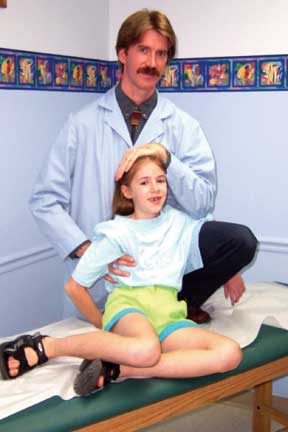Osteopathic Management Case Study: Somatic Dysfunction Causing Adolescent Chest Pain – Counterstrain Treatment
Source: www.acofp.org/member_publications/0405_4.htm

An example of a seated counterstrain treatment for a patient with anterior right fifth rib tenderpoint.
Chest pain is a common reason for patients to present to the osteopathic family physician's office. Chest pain can be complicated, even with adolescents and children. It is important to consider visceral etiologies, such as heart disease and upper gastrointestinal pathologies, but it is also important to diagnose and treat the musculoskeletal aspects of these patients (especially when visceral pathology has been ruled out). Counterstrain is one form of osteopathic manipulative medicine (OMM) that lends itself well to this situation of acute pain in an adolescent. This case illustrates the use of treating a young adolescent with chest pain.
Name of Technique: Counterstrain treatment for anterior fifth rib tenderpoint with patient seated.
Diagnosis: Tenderpoint at right fifth rib laterally at the anterior axillary line. This is termed a “depressed” rib in counterstrain terminology and it responds to treatment with a position of ease that further depresses the rib anteriorly.Patient Position:Seated on a low exam table.Physician Position:Standing behind the patient on the side opposite the dysfunctional rib, in this case standing to the left side. Physician places their left foot on the table next to patient with a small pillow on top of that knee.
Procedure:
- Locate the right fifth rib anterior tenderpoint, at the anterior axillary line, with the right index or long finger. Test the point with brief firm palpation. Have the patient gauge the tenderness on a scale of one to ten.
- Patient places the left forearm and arm (flexed at the elbow) over the physician's knee. Translate the patient gently to the left, localizing side bending to the right at the fifth rib tenderpoint. Not much side bending is needed.
- Hold the patient's head and neck with your left forearm and hand. Then flex the head forward, with some side bending to the right to relieve tension at the tenderpoint. Add rotation to fine tune localization. Usually rotation is needed toward the involved side, but occasionally it will be needed in the opposite direction.
- Fine tune all planes of motion, including subtle rotation of the trunk.
Reassess the tenderpoint. There should be a 70 percent, or greater, reduction in tenderness. Then monitor the point with very gentle pressure. Remember, this is not an inhibitory pressure technique. - Hold for approximately 90 seconds. You should feel a gradual softening of the involved tissues. Sometimes, you may feel a therapeutic pulsation. This indicates a good response to treatment.
- Slowly move the patient back to an independent seated position. The first few degrees of movement should be very slow, and then the rest may be done more quickly.
Reassess the tenderpoint with firm localized palpation. A reduction in tenderness of at least a seventy percent indicates a therapeutic response.
0 Comments:
Post a Comment
<< Home